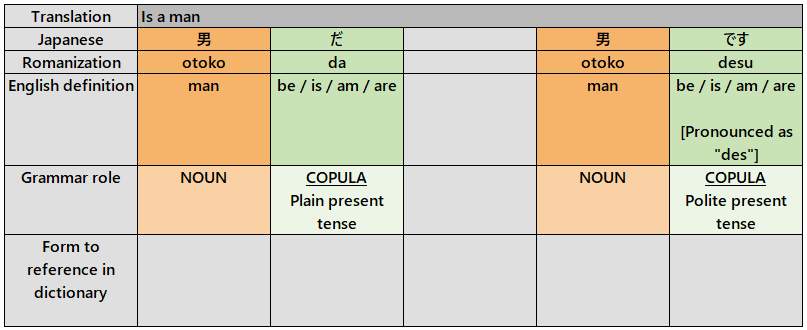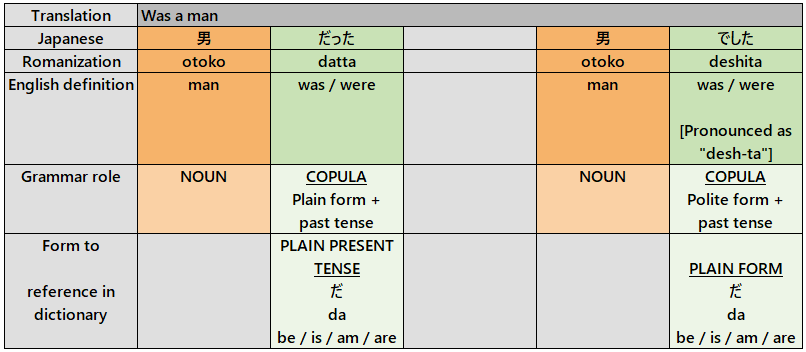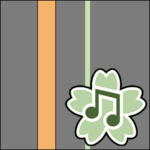
I will start by defining what a copula is in terms of general grammar, then ease into how they are used in Japanese.
To start, let’s make sure we know how to pronounce this funny little word:
For our purposes, we will use the least complicated explanation possible and say a copula is simply a word that means “is”.
I wish I could leave it at that, but the word “is” has a surprising amount of uses, so I want to make sure we go over them.
When I say a copula means “is”, I am really saying that it means “to be”.
First of all, “is” can become “am” or “are” depending on how you use it. For example…
He is a teacher.
I am a teacher.
They are teachers.
In all of these cases, “is / am / are” means “(to) be”.
Okay, I know, I know… You’re going to get mad at me for being the bearer of bad news, but when I said a copula means “is”, I meant that it’s not just “be / is / am / are”. There are other tenses, too.
They are “being”, “was”, “were”, and “been”. But don’t worry, I won’t go into detail about these… in English.
We’re here to learn Japanese, so I will be explaining about conjugating the tenses of Japanese copulas and won’t torture you with any more English.
Now that we’re done with the generic explanation of copulas in general, we can move on to how copulas are specifically used in Japanese!
To start, on Learn JP Lyrics, we color copulas light green. Why? Because copulas go towards the end of a sentence.

I mentioned before that there are multiple ways to conjugate “is”– as in more than one tense (such as conditional form). But we will keep it simple for now and only focus on present and past tense. We will learn more complex conjugations on later pages.
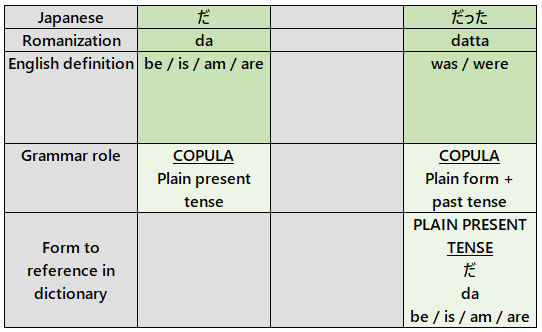
I want to let you know right away that Japanese has more than one level of politeness when speaking to others.
For “だ / da” which you just learned, it is considered “plain”, and is used when speaking to yourself, speaking to friends rather than someone of higher social status (like a boss or a stranger), and used to build sentences with slightly more complex grammar (ex: used for quotes).
The next way to say “is” is “です / desu”, and it is more polite than “だ / da”. Most textbooks aimed at beginners of Japanese will learn “です / desu” first, rather than “だ / da”, because “です / desu” is more useful for an adult presumably wanting to be polite in the workplace or during a vacation. It’s a safe thing to teach students, but I think being limited to “です / desu” until a textbook suddenly drops the “だ / da” bomb can cause confusion once grammar becomes more complex (old habits die hard).
That is why I want to introduce each right away, because they are important for crafting both a grammatically correct sentence and one with the correct politeness. Plus, lyrics mainly use “だ / da”, so we will see it a lot on Learn JP Lyrics!
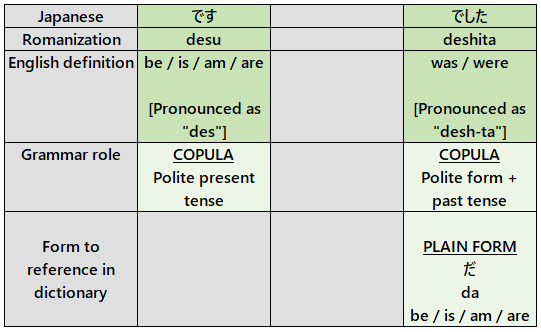
Japanese conjugation is extremely uniform. There are few exceptions to the rules. Verbs conjugated to past tense always end with “~た / ~ta” or “~だ / ~da”! (Note: Copulas are sometimes called auxiliary verbs– helping verbs.) We will learn how to conjugate verbs later.
Using one of the nouns we learned on the previous page, I will show you how to build a plain and a polite sentence in both present and past tense.
In Japanese, the word order is not the same as English. The copula always goes at the end. If you are a Star Wars fan, some of Yoda’s quotes are in a Japanese-esque order, such as this quote: “The greatest teacher, failure is.”
